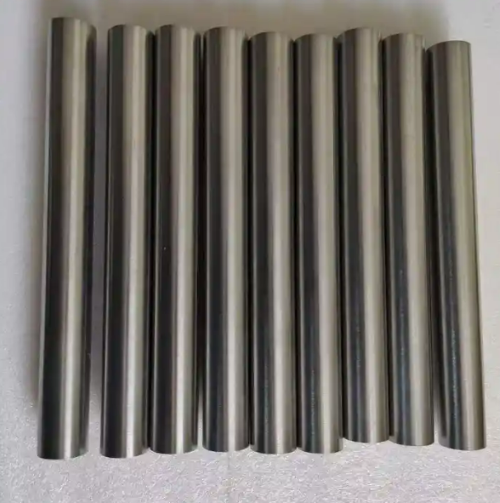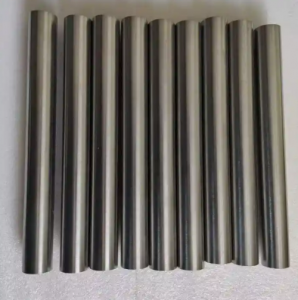Tungsten-Nickel-Copper Alloy: Types and Applications

Introduction:
The fusion of tungsten, nickel, and copper in an alloy brings forth a composite material-- Tungsten-Nickel-Copper Alloy. It is renowned for its exceptional properties and diverse applications. This article delves into the unique characteristics, manufacturing processes, and widespread utilization of tungsten-nickel-copper alloy across various industries.

W-NI-CU alloy
Types of Tungsten-Nickel-Copper Alloy:
Tungsten-nickel-copper (W-Ni-Cu) alloys come in various compositions. Each of them is designed to cater to specific applications. Here are some types of W-Ni-Cu alloys commonly utilized across industries:
1. High-Density Alloys:
W-Ni-Cu Alloys with High Tungsten Content: These alloys have tungsten contents ranging from 90% to 97%. They exhibit exceptionally high density and excellent mechanical strength. They are often employed in aerospace, defense, and high-tech applications requiring superior radiation shielding or vibration-dampening properties.
2. Low-Density Alloys:
Moderate Tungsten Content Alloys: These alloys contain tungsten in the range of 70% to 90%. They possess a balance of density, strength, and machinability. Thus, they are suitable for various industrial tooling, heavy machinery parts, and radiation shielding applications.
3. High Thermal Conductivity Alloys:
W-Ni-Cu Alloys Emphasizing Thermal Conductivity: Some compositions focus on maximizing thermal conductivity. These alloys, with optimized proportions of nickel and copper, find use in electronics, heat sinks, and electrical contacts where efficient heat dissipation is crucial.
4. Specialty Alloys:
Customized W-Ni-Cu Alloys: Tailored compositions are engineered to meet specific application requirements. These can include variations in tungsten, nickel, and copper content to achieve desired properties like corrosion resistance, wear resistance, or enhanced machinability based on industry-specific needs.
5. Radiation Shielding Alloys:
W-Ni-Cu Alloys for Radiation Shielding: These alloys feature balanced tungsten, nickel, and copper ratios and ensure effective radiation attenuation. They are extensively used in medical devices, X-ray equipment, and nuclear applications requiring reliable radiation shielding properties.
6. Machinable Alloys:
W-Ni-Cu Alloys with Improved Machinability: Some compositions are engineered with adjusted ratios to enhance machinability while maintaining essential properties. These alloys are favored in applications where ease of machining is critical without compromising overall performance.
|
Type |
Composition |
Key Properties |
Applications |
|
High-Density |
90%–97% W |
High density, strength |
Aerospace, defense, radiation shielding |
|
Low-Density |
70%–90% W |
Balanced density, machinability |
Tooling, machinery, radiation shielding |
|
High Thermal Conductivity |
Optimized Ni, Cu |
Efficient heat dissipation |
Electronics, heat sinks, electrical contacts |
|
Specialty Alloys |
Custom W-Ni-Cu ratios |
Tailored properties |
Industry-specific needs |
|
Radiation Shielding |
Balanced W-Ni-Cu |
Radiation attenuation |
Medical devices, nuclear applications |
|
Machinable Alloys |
Adjusted W-Ni-Cu |
Enhanced machinability |
Applications requiring precision machining |
The Alloy's Exceptional Attributes:
The tungsten-nickel-copper alloy boasts exceptional attributes. These features set it apart and cater to diverse needs in multiple sectors.
1. Exceptional Strength and Density:
Tungsten is known for its high density and robustness. Yet, it combines with nickel and copper to create an alloy with superior strength and durability. Such a combination results in a material capable of withstanding extreme temperatures and mechanical stress.
2. Thermal and Electrical Conductivity:
The addition of copper enhances the alloy's electrical conductivity, while nickel contributes to its thermal conductivity. This combination yields a material suitable for applications requiring efficient heat dissipation and electrical conduction.
3. Corrosion Resistance:
The unique corrosion resistance makes it an ideal choice for environments prone to chemical exposure or corrosive substances. Its resilience against oxidation and chemical degradation ensures longevity in diverse conditions.
Manufacturing Process and Composition:
The manufacturing process of the Tungsten-Nickel-Copper (W-Ni-Cu) alloy is quite complex. Here are some key steps.
1. Powder Metallurgy:
The production process often involves powder metallurgy techniques. The raw materials include tungsten, nickel, and copper powders. They are meticulously blended in precise ratios. Subsequently, they undergo compaction and sintering processes under controlled temperatures and pressures to form the desired alloy.
2. Alloy Composition:
The composition ratios typically range. Tungsten content often ranges from 70% to 95%. This is accompanied by nickel and copper in varying proportions. Fine-tuning these ratios allows manufacturers to tailor the alloy's properties to meet specific industrial requirements.
Wide-Ranging Applications:
The Tungsten-Nickel-Copper alloy boasts an impressive array of applications across diverse industries. Its unique combination of properties makes it a sought-after material in various sectors:
1. Aerospace and Defense:
Tungsten-nickel-copper alloy finds extensive use in aerospace and defense applications. Its high density and strength make it suitable for aerospace components. Such uses involve gyroscopes, aircraft balance weights, and kinetic energy penetrators used in defense systems.
2. Electronics and Electrical Engineering:
The alloy's thermal and electrical conductivity renders it valuable in electronics. It serves in heat sinks, electrical contacts, and components requiring both high strength and electrical conductivity.
3. Medical Devices and Radiation Shielding:
Within the medical field, the alloy contributes to the production of radiation shielding materials used in X-ray and radiation therapy equipment. Its density enables effective radiation attenuation and safety in medical procedures. Related reading: Tungsten Nickel Copper Alloy For New Medical X-Ray Protection
4. Industrial Machinery and Tooling:
Tungsten-nickel-copper alloy possesses robustness and resistance to wear. So, it is suitable for industrial tooling, heavy machinery parts, and components requiring durability and longevity.
Future Innovations and Prospects:
The future prospects for W-Ni-Cu alloys brim with potential innovations across industries. Advancements in alloy compositions, manufacturing techniques, and tailored properties are on the horizon.
1. Advancements in Alloy Compositions:
Ongoing research focuses on optimizing alloy compositions to enhance specific properties, such as improved machinability, increased corrosion resistance, and further tailored strength characteristics.
2. Sustainability and Environmental Impact:
There are also efforts toward sustainable production methods and recycling initiatives. They aim to reduce environmental impact while ensuring the alloy's availability for future applications.
Conclusion:
The blending of tungsten, nickel, and copper in an alloy enhances its strength, resilience, and adaptability. Its widespread applications across industries underscore its indispensable role in powering innovation, reliability, and efficiency in diverse sectors, marking it as a vital component of modern technological advancements. With two decades of expertise, Advanced Refractory Metals (ARM) excels in producing and supplying top-tier tungsten-nickel-copper (W-Ni-Cu) alloys. A diverse array of shapes is readily available. They ensure versatile applications across industries. For more information, please check our homepage.
{{item.content}}
LEVE A REPLY
{{item.children[0].content}}
{{item.content}}






